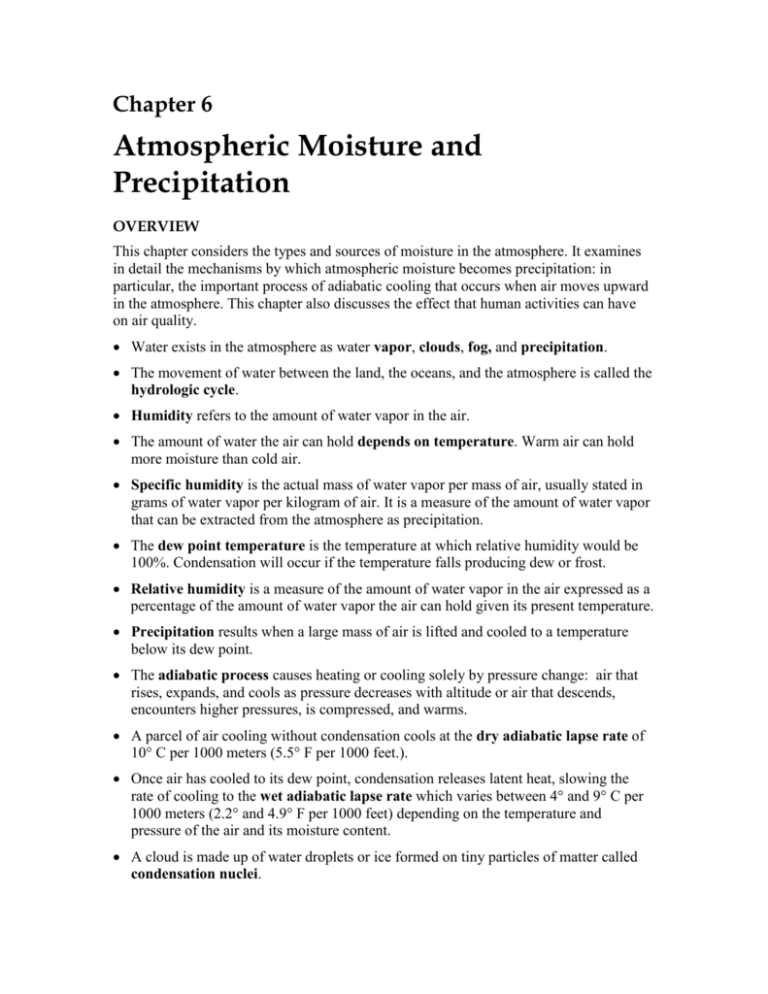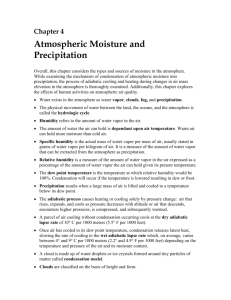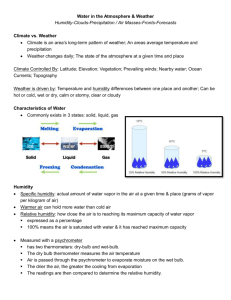On-Line Study Guide
advertisement

Chapter 6 Atmospheric Moisture and Precipitation OVERVIEW This chapter considers the types and sources of moisture in the atmosphere. It examines in detail the mechanisms by which atmospheric moisture becomes precipitation: in particular, the important process of adiabatic cooling that occurs when air moves upward in the atmosphere. This chapter also discusses the effect that human activities can have on air quality. Water exists in the atmosphere as water vapor, clouds, fog, and precipitation. The movement of water between the land, the oceans, and the atmosphere is called the hydrologic cycle. Humidity refers to the amount of water vapor in the air. The amount of water the air can hold depends on temperature. Warm air can hold more moisture than cold air. Specific humidity is the actual mass of water vapor per mass of air, usually stated in grams of water vapor per kilogram of air. It is a measure of the amount of water vapor that can be extracted from the atmosphere as precipitation. The dew point temperature is the temperature at which relative humidity would be 100%. Condensation will occur if the temperature falls producing dew or frost. Relative humidity is a measure of the amount of water vapor in the air expressed as a percentage of the amount of water vapor the air can hold given its present temperature. Precipitation results when a large mass of air is lifted and cooled to a temperature below its dew point. The adiabatic process causes heating or cooling solely by pressure change: air that rises, expands, and cools as pressure decreases with altitude or air that descends, encounters higher pressures, is compressed, and warms. A parcel of air cooling without condensation cools at the dry adiabatic lapse rate of 10° C per 1000 meters (5.5° F per 1000 feet.). Once air has cooled to its dew point, condensation releases latent heat, slowing the rate of cooling to the wet adiabatic lapse rate which varies between 4° and 9° C per 1000 meters (2.2° and 4.9° F per 1000 feet) depending on the temperature and pressure of the air and its moisture content. A cloud is made up of water droplets or ice formed on tiny particles of matter called condensation nuclei. Clouds are classified on the basis of height and form. Clouds at ground level are called fog. Radiation fog forms when the temperature of the air near the ground falls below the dew point. Advection fog occurs when warm moist air is cooled below dew point as it moves over a cold surface. Precipitation forms when either cloud droplets or ice crystals increase in size by colliding with each other until they are heavy enough to fall. Precipitation that occurs as a result of air being forced over a topographic barrier is called orographic precipitation. Air that rises because it is warmer than the air around it produces convectional precipitation, and air that is forced to rise over another air mass produces cyclonic precipitation. Thunderstorms are intense convectional storms associated with massive cumulonimbus clouds. They may produce heavy rains, hail, thunder, lightening, and intense downdrafts (microbursts) which may create hazards for humans. Air pollutants are undesirable gases, aerosols, and particulates injected into the atmosphere by human and natural causes. The most important human source of pollutants is the combustion of fossil fuels for the production of energy for transportation, heating, and industrial processes. Urban air pollution produces smog and haze which reduce visibility and illumination. Urban areas also experience more fog, cloudiness, and precipitation than adjacent rural areas. Acid deposition refers to acid rain and acidic dust particles produced by emissions of sulfur dioxide and nitric oxide. Acid deposition is very damaging to natural ecosystems. KEY TERMS sublimation deposition hydrologic cycle humidity relative humidity specific humidity dew point temperature adiabatic processes condensation nuclei radiation fog advection fog orographic precipitation convectional precipitation cyclonic precipitation rainshadow unstable air thunderstorm microburst smog temperature inversion pollution dome pollution plume acid deposition STUDY QUESTIONS 1. Draw a diagram of the hydrologic cycle. Label where water is stored on the Earth. Label the pathways along which water moves from ocean to land and from land to ocean. 2. Explain the global distribution of specific humidity. How do you think relative humidity varies globally? 3. What is the adiabatic process? Why does the dry adiabatic lapse rate differ from the wet adiabatic lapse rate? 4. List the most common high, medium, and low cloud types. 5. What are the two processes through which precipitation forms? 6. Describe the mechanisms that force air to rise, cool, and produce precipitation. 7. How is an unstable situation in the atmosphere produced? 8. Explain the formation and effects of thunderstorms. 9. What are the main air pollutants? How are these pollutants produced? 10. What effect does a temperature inversion have on pollution in an area? 11. What are the effects of acid deposition? CHAPTER QUIZ Multiple Choice Questions 1. If the temperature of the air decreases without the addition or subtraction of water vapor, relative humidity will: a) increase b) decrease c) remain the same d) there is no relationship between temperature and relative humidity 2. Clouds that appear blanket-like or layered are called: a) stratus b) nimbus c) cumulus d) cirrus 3. Fog that occurs when warm moist air moves over a cold surface is: a) radiation fog b) advection fog c) sea fog d) land fog 4. Which of the following is the result of convection cell activity? a) lightening b) hail c) thunder d) all of the above 5. The largest contributor to air pollution in the United States is: a) burning solid waste b) transportation c) thermal power d) industrial processes True/False Questions 1. Precipitation over land is greater than precipitation over water. (T/F) 2. The concentration of pollutants over urban areas is decreased during a temperature inversion. (T/F) 3. The dry adiabatic lapse rate is lower than the wet adiabatic lapse rate due to the release of latent heat. (T/F) 4. Latent heat is released when water vapor changes to liquid water. (T/F) 5. Stable air will rise to great heights and create thunderstorms. (T/F) Short Answer Questions 1. Distinguish between relative humidity and specific humidity. 2. Define the wet adiabatic lapse rate and the dry adiabatic lapse rate. Explain why the former is always less than the latter. 3. Why does precipitation sometimes occur in the form of snow rather than rain? Short Essay Questions (1 - 2 paragraphs) Describe the orographic precipitation process and explain how it can produce a rainshadow effect. 2. Describe how the many forms of water in the hydrosphere are linked through the hydrologic cycle. 1. Internet Resources 1. Cloud classification – description and photos: <http://australiasevereweather.com/techniques/moreadv/class.htm#1> 2. Clouds and precipitation with extensive discussion of the mechanisms by which precipitation is generated: <http://ww2010.atmos.uiuc.edu/(Gh)/guides/mtr/cld/home.rxml> 3. Collecting water from fog: <http://www.idrc.ca/library/document/096904/index_e.html#top> 4. A look inside a thunderstorm: <http://www.usatoday.com/weather/tg/wtsmwhat/wtsmwhat.htm> 5. Current atmospheric water vapor images from satellites: <http://weather.unisys.com/satellite/sat_wv_west.html?








